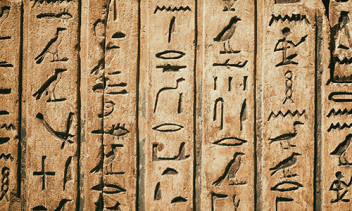There have been many faces to the complicated relationship between Judaism and science throughout history, and we want to respect the complexity. To help you understand the many angles, we prepared a short timeline of this relationship, from the Bible until today. We hope you enjoy, and continue to think about science and religion with us.
Biblical Era
Does the Torah make scientific claims? While the truths of the Great Book are timeless, the domain in which these truths rest are the subject of millennia of controversy. For some thinkers, a Book of such eternal wisdom must necessarily include all other wisdoms, and these other wisdoms (such as science) may even be accessible through Torah study. “Turn it around, turn it around, for all is in it,” as Ben Bag Bag famously taught (Avot 5:22), becomes for some the catchall support for the all-encompassing nature of the Torah, which includes scientific wisdom as well. Others (notably the Rambam, as we will see), limit the Torah to a book that teaches timeless religious truths, but not scientific truths. Defining the genre of the Great Book is one fundamental ambiguity that follows the many controversies of science and religion throughout history.
Talmudic Era
The Talmud’s perspective on science is a wonderfully complex area of discussion. Extensive analysis of botany, zoology, astronomy, philosophy, and medicine all occupy pages of the vast Talmud. However, in other ways the Talmud is more conflicted about the place of science and Torah. While the sages at times consulted doctors (Hullin 77), possible Talmudic errors about science (such as the famous Talmudic half-mouse half-dirt creature) have led to serious debate about the possibility of error in the Talmud. There is no one easy understanding of the Talmud, or of the Talmud’s treatment of science, but the complexity modelled by the early Talmudic sages in engaging with scientific knowledge set the stage, in many ways, for the future of Jewish thought.
Medieval Era: Reason and Revelation
The medieval era saw the beginning of the rich, yet tense, relationship between science and Jewish thought. From Saadia Gaon’s philosophical writings to Ibn Gabirol, Ibn Pakudah, and Yehuda HaLevi, engaging with contemporary scientific and philosophical theories was accepted practice. The translation movement in the Jewish community of Provence, which placed an emphasis on translating scientific writings into Hebrew, brought a more widespread engagement with science to Jewish intellectual life. Most importantly, the Ibn Tibbon family’s translation of Rambam’s Guide to the Perplexed – along with a host of other scientific and philosophical writings, such as Aristotle and Averroes – introduced a new era of Jewish engagement with science. Questions of reason and revelation were hotly debated, with Rambam’s assertion that reason should be occasionally prioritized over outdated rabbinic science hotly contested by his contemporaries. Rambam’s further controversial statement about the nature of the maaseh merkava cemented his role as primary Rishonic provocateur for generations to come. (For more on the Rambam’s scientific and religious views, Menachem Kellner’s Science in the Bet Midrash is a must-read).
Early Modern Era: Pantheism and Copernican Thought
With the advent of modernity and modern scientific thinking, science posed greater challenges to all prior doctrines that offered interpretation or meaning of the natural world. In each era of advancement in knowledge, scientific inquiry is often mirrored, responded to, and engaged by Jewish thinkers. In the 17th century, Spinoza’s pantheistic philosophy – which (in a very oversimplified manner) identified God with nature – provoked religious response and engagement, particularly in the figure of Rabbi David Nieto. Rabbi Nieto, a Chacham of the Spanish-Portuguese congregation in London, engaged directly with (and rejected) the pantheistic thought that was well known at the time, and was widely censured by those who feared his engagement with the controversial topic.
A few hundreds years later, in the 15th-16th centuries, Nicolaus Copernicus’s introduction of heliocentric theory stirred Jewish thought in myriad ways. Copernicus gets a veiled reference in Maharal’s Netivot Olam, and a student of the Maharal, David Gans, dealt with Copernicus explicitly in his book on astronomy, Nehmad Vena’im, although he ultimately rejected Copernicus for the geo-heliocentric theory (the sun and the moon circle the earth, but other planets circle the sun) of Tycho Brahe. In Jeremy Brown’s ground-breaking New Heavens and a New Earth: The Jewish Reception of Copernican Thought, Jeremy provides a full treatment of the Jewish reception of Copernican thought, and sees the way Jews dealt with Copernicus as a test case for the ways science and religion meet.
Late Modern Era: Evolution
The religious world was particularly struck when faced with Darwin’s evolutionary theory in the early 20th century. Acceptance, rejection, and synthesis all marked rabbinic responses to evolution, as a number of deeply intriguing articles on rabbinic responses indicate. In the acceptance camp, Rabbi Avraham Yitzchak Kook saw in evolution a “gradual, evolutionary development in the world’s most spiritual essence.” Rabbi Menachem Mendel Kasher – a rejectionist – disagreed, seeing in the Biblical phrase “after their kind” a rejection of evolutionary theory. Particularly fascinating, Kasher argued that the actions of the Nazis indicates the paucity of such a spiritual evolution, and that any such progress must rather come from above, not below. Rabbi Yitzchak HaLevi Herzog presents as a synthesis figure in his belief that scientific matters should not be under the authority of rabbinic sages. Like the prior conflicts between science and religion, perspectives often reflect the prior conceptual paradigms of each thinker, each birthing insights fitting with their own worldview.
Contemporary Era: Looking Forward
With the radical democratization of religious culture afforded by the Internet, the nature of rabbinic discourse fundamentally changed. In one of the first great controversies of this new era, the boundaries of what is acceptable and unacceptable in the public conversation were tested in the so-called “Slifkin Affair,” in which the work of Rabbi Natan Slifkin, who wrote books on Jewish zoology, were banned. As religious culture and conversation now occur on a far more public stage than ever before, this religious controversy of the internet age indicated that the intense religious fervor of previous eras surrounding the topic of science and religion is by no means dead, although it may have taken a different form today.








